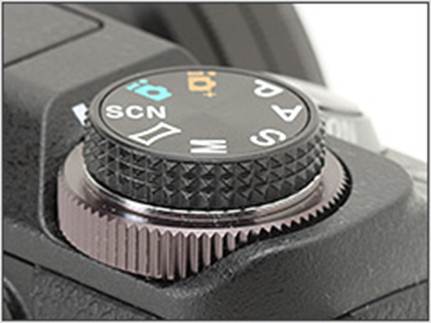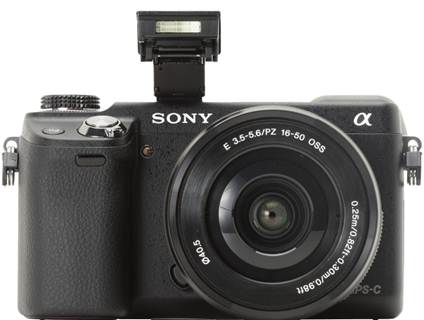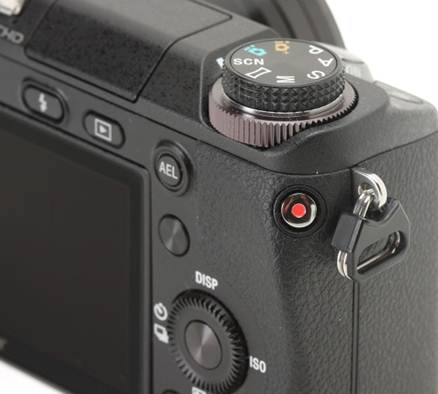Body and Design

The Sony NEX-6
viewed from four different sides
All of the recent NEX-series cameras have followed quite a
suitably aesthetic design, and thus there are plenty of similarities between
the NEX-6 and NEX-5R, and to a lesser level than the NEX-7. Like the NEX-7, an
extra wide deep battery that extends from the top panel of the camera with a
sharply sloped platform containing the only controls found on the front, a
power switch that surrounds the shutter button and an Fn button.

In typical NEX
style the silver-colored lens mount extends outwards from the front of the
body, while the articulated LCD screen at the rear is placed flat with the
camera back. The control dial is located directly in line with the thumb of
your shooting hand.
Most of the camera's controls of the NEX-6 are found on the
back, with a specialized flash, playback and a customizable AEL button along
the upper edge. A four-way control dial with the center button is placed between
the two 'soft keys'. Movie recording is likely to be started from any shooting
mode with a single press of a button, just up on the right corner of the
camera. This position is a bit strange, which may due to reaction (reasonably)
to the random operation of the movie mode on the NEX-7.
A notable difference between the NEX-6 with any previous
models in the same product lineup which consists of an eight-mode exposure dial
located on the top plate. Clamped directly below it is a greater-circumference
control dial. An integrated flash, a new standard ISO hot shoe (it also has
exclusive multi-interface port of Sony) and OLED viewfinder with adjacent
diopter round out the remaining controls.
Compared to the NEX-7
In terms of specs, there is extremely little, except for the
megapixel number (16MP versus 24MP) and pricing is to separate the NEX-6 from
Sony’s high-end NEX-7. If you do not want the performance to exceed 16MP and
are willing to exchange the NEX-7's Tri-Navi control interface with an external
mic socket for a mode dial, Wi-fi connection and Quick Navi menu, you are able
to pick up the NEX-6 with a 16-50mm F3.5-5.6 OSS power zoom that is co-released
for a notable MSRP for the price of $999. Sony has admitted that they expect
the NEX-6 to have a direct impact on sales of premium NEX-7 cameras. It is
clear that Sony considers this to be a risk worth giving it a try.

From the front,
the NEX-6 is almost indistinguishable from the NEX-7
From the front, the NEX-6 is almost indistinguishable from
the NEX-7; it is a little higher only due to its protruding mode dial. It has
more rounded edges along its top plate and misses the metal structure of Sony's
flagship model, but is still a camera that feels solid.

Both cameras
combine with the same 3-inch LCD screen OLED viewfinder.
Both cameras combine with the same 3-inch LCD screen OLED
viewfinder. Button layout is very similar, with the only difference in the
arrangement of movie record button (this problem was much criticized on the
NEX-7 because it was too easy to press accidentally). The NEX-6 features two
control dials (as opposed to the three buttons on the NEX-7) and an exposure
mode dial. It is also missing an AF / MF switch. The NEX-6 is shown here with
the bundled rubber eyepiece cup. The NEX-7 also has an eyecup (but ours has
been dropped).

On the top plate,
there are fewer points to distinguish the cameras except for their dial
arrangement and the ISO-standard hotshoe on the NEX-6.
On the top plate, there are fewer points to distinguish the
cameras except for their dial arrangement and the ISO-standard hotshoe on the
NEX-6. However, the small power zoom kit lens brings much wider coverage and
reach is equivalent to the older 18-55mm lens on the NEX-7 older, which creates
a much more compact package.
Compared to Panasonic Lumix DMC-GX1
The 16MP Panasonic Lumix DMC-GX1 is one of the closest
competitors of the NEX-6 both in terms of design and specification. However, it
is worth noting that it lacks an equivalent to the integrated electronic
viewfinder of the NEX. Here's how to compare the two machines together, in the
tangible aspect.

The fronts of Sony
NEX-6 and Lumic Panasonic DMC-GX1

The NEX-6 and GX-1
are almost identical in height.
The NEX-6 and GX-1 are almost identical in height. The NEX-6
provides an integrated OLED EVF (an optional fastened LCD unit is available for
the GX-1) and an articulated LCD screen at the rear (compared to the fixed
one), though it does not have touchscreen capacities found on the GX-1. Both
cameras provide an integrated flash; and the layout of the external control
points are arranged mainly along the right side of their rear parts.

Both cameras have
a mode dial and a standard accessory hotshoe.
Both cameras have a mode dial and a standard accessory
hotshoe. The NEX-6 has a much more protruding handgrip, which provides a
platform for the power switch, shutter and Fn buttons. The new 16-50 power zoom
kit lens causes the NEX lineup to come closer than it has ever been to
competing with mirrorless competitors in terms of its overall size.
Impressively, the new kit lens is actually not longer than the 14-42mm power
zoom of the GX-1, but the NEX viewfinder (shown here with its rubber eyecup)
contributes to a thicker size overall. Of course, it is still more compact than
the Panasonic when the GX1 is fitted in its optional EVF.
Body elements

The NEX-6 is the
first version of this lineup to feature an external mode dial. It is located on
the top of the control dial on the larger circle on the top right.
. 
A new multi-interface
hotshoe allows for ISO standard accessories - the first for the NEX lineup.
Hidden underneath the chassis at the front of the shoe though are the
non-standard connector platforms allow for use of Sony's own lineup of
exclusive accessories.

The built-in flash
brings the same GN (6 at ISO 100) as the unit on the NEX-7, but offers rather
broader coverage to adjust the 24mm equivalent wide angle of the new 16-50mm
kit lens. Performance can be adjusted with exposure compensation of + / - 2
stops EV.

Sound microphones
are located behind small holes placed above the lens mount.

The movie record
button is placed concavely, slightly awkwardly, along the right edge of the
camera at a 45 degree angle. While requiring a two handed hold of the camera,
its location prevents inadvertent activation, which turns into a serious issue
on the NEX-7.

Like the other
models in the same series, the NEX-6 features a 4-way control dial with a
confirmation button in the center.
Along with its four directions, you'll find direct access
for the display mode, ISO, exposure compensation, and drive mode. The camera’s
two 'soft keys' sit above and below the dial plate.

The connectors of
the NEX-6 include a USB and HDMI port, but unlike the NEX-7 there is no 3.5mm
input for the external mic.
Those who wish to use an external mic have to use one of the
Smart Accessory compatible models of Sony that is likely to connect through the
multi-faceted hotshoe.
Sony announces that the battery offers 360 images per charge
with the rear LCD screen and 270 when using the EVF, based on CIPA standard
testing.

The tripod mount
is united with the center of the lens axis.
Because of the NEX-6's ultra-slim body and tilt screen,
there is very little space on the plate for a quick removable plate to hold
tightly.